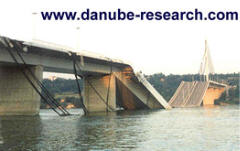
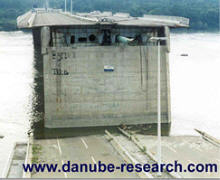
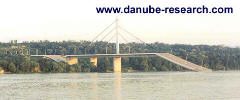
Eight bridges over the River Danube were destroyed or damaged during NATO's campaign against Yugoslavia in 1999. Three of these bridges were in Novi Sad, the capital of Vojvodina in northern Serbia.
To date three replacement bridges have been opened, two of them permanent structures.
Since the political change in Yugoslavia in 2000 the Clearance Project Unit (85% funded by the European Commission) of the Danube Commission progressed with organising the clearance work. In April 2001 the contract for architectural assistance was awarded and in early 2002 contracts were awarded for demining and for the removal of debris from each of the three bridges. A safe marked fairway was opened in November 2001 and the clearance work itself was completed in June 2003.
This page provides basic details of the three bridges bombed by NATO and the three replacement crossings presently in place. Bridges are listed in correct order from west to east. Details of the relevant activities of Danube Research are also included.
Sloboda Bridge
Temporary pontoon bridge
Rainbow Varadin Bridge
Petrovaradin Bridge
Temporary road/railway bridge
Zezelj Bridge
Bridges before NATO
Danube Research and
the Clearance of the River Danube
km 1257.6



The graceful Sloboda ("Freedom") Bridge opened in 1981 and carried the 6-lane Novi Sad - Sremska Kamenica road across the River Danube. It is sometimes referred to as the Kamenica Bridge. Designed by Prof. Dr. Nikola Hajdin the bridge was the pride of Yugoslavian engineering. Around 20:00 hours on 3 April 1999 the bridge was disabled by three NATO missiles. The bridge finally reopened as the "Europa" Bridge based on the original design in October 2005.
Temporary pontoon bridge (Privremeni pontonski most)
km 1255.3
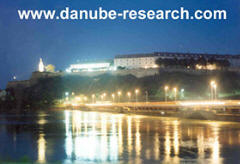
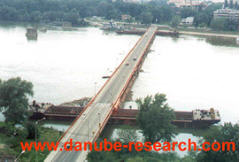
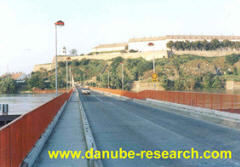
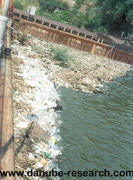
Floating debris accumulated against the pontoon bridge. This mostly consisted of plastic soft drinks bottles and tree branches.
The temporary pontoon bridge was the first "fixed" crossing of the Danube to open in Novi Sad following the NATO bombing campaign, which downed all three of the city's bridges. The pontoon bridge was made up of barges belonging to Heroj Pinki, a Novi Sad - based river engineering and shipping company. Until the pontoon was completed in September 1999 Novi Sad and Petrovaradin were connected by makeshift ferry services.
Until Summer 2001 the pontoon bridge was only opened to allow vessels through about twice a month, however the Serbian Transport Minister agreed to open the bridge weekly as of August 2001. From January 2002 the bridge was opened twice per week and from March 2002 three times per week, largely due to negotiations by the Danube Commission. Nevertheless shipping companies the length of the river demanded that the bridge be removed as it continued to irrecoverably damage their trade and therefore the economy of all riparian states. The then Serbian Transport Minister, the Right Honourable Marija-Raseta Vukosavljevic told Danube Research in June 2001 that only after the Sloboda Bridge is repaired and reopened will the authorities consider removing the pontoon and this promise was kept, with the pontoon bridge finally being removed in late 2005. A charge of EUR 0.10 per registered tonne that passed through the bridge was a further major constraint to Danube transport (reduced from the EUR 0.40 and before which DM 3,- per tonne previously charged) except for passenger vessels which passed free of charge.
[Petro]Varadin Bridge (Varadinski Most)
km 1255
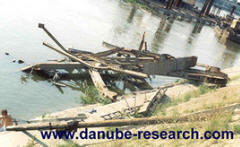
Some of the few remaining steel girders of the Varadin Bridge above the water in 2001
Formerly called the Marshall Tito Bridge, the Varadin Bridge was built in 1946 and became one of the symbols of Novi Sad. It carried pedestrians and light traffic across the Danube, although was defined by NATO as a "strategic target" and was the first bridge to be attacked, at 05:00 hours on 1 April 1999. The lowest bridge on the middle and lower section of the Danube, this bridge caused problems to Danube shipping at times of high water. Vessels had to lower their masts to pass under and were sometimes forced to wait until water levels dropped to allow sufficient air draught. An ambitious scheme to raise the bridge by two metres to provide suitable clearance had been planned.
Rainbow Varadin Bridge (Most Varadinska Duga)
km 1255
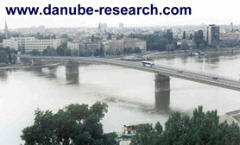
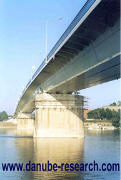
The first permanent crossing to be opened in Novi Sad following the NATO campaign was the Rainbow road bridge, built on the pillars of the Varadin Bridge (heightened by 2.5m to provide sufficient clearance for river vessels) and opened in October 2000.
km 1254.24
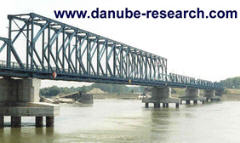
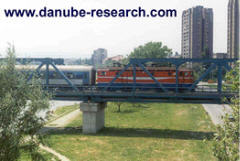
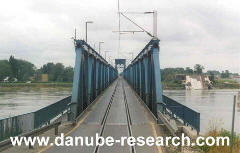
International trains via Budapest to Belgrade could proceed no further than Novi Sad following the destruction of the Zezelj Bridge. The replacement railway bridge was a priority to the Yugoslavian government and was opened by Slobodan Milosevic in May 2000. However the bridge is very much a temporary structure and will need a more substantial replacement in the next few years. The bridge consists of a single flushed railway track, so road traffic crosses in turn except when a train is crossing.
km 1254.17
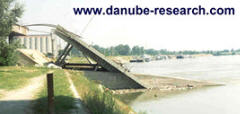
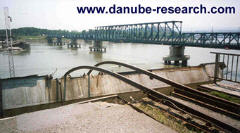

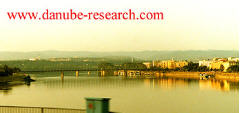
Novi Sad bridges prior to destruction: view from the Zezelj
Bridge showing the Petrovaradin Bridge with the top of the Sloboda
Bridge just visible in the distance.
Danube Research and the Clearance of the River Danube
Danube Research assisted a wide variety of companies and organisations involved with the clearance of the Danube in Novi Sad.
-We have assisted a multinational engineering company tender for the architect contract and assisted a consortium of companies who successfully tendered for bridge clearance work
-We have provided a report on Danube vessel types and specifications to COWI-Utiber, the Danish-Hungarian consortium who won the architect tender
-We have provided shipping and riverbed intelligence to companies involved with undertaking the clearance works
-We write regular articles in the shipping press updating the Danube clearance issue
-We designed and maintained the official website of the Danube Commission Clearance Project Unit [no longer available as the Clearance Unit has now completed it's task]